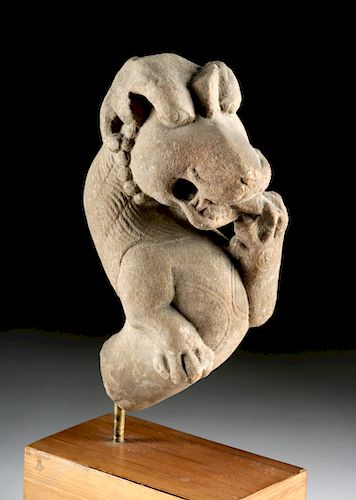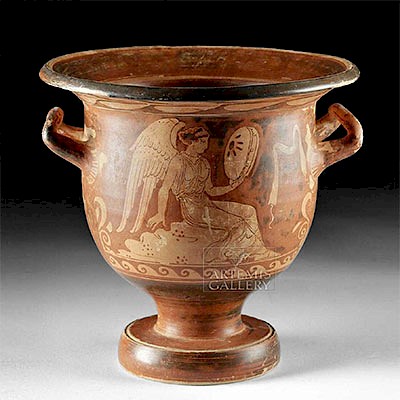Indian Gupta Stone Ram Attachment
Lot 134c
About Seller
Artemis Fine Arts
686 S Taylor Ave, Ste 106
Louisville, CO 80027
United States
Selling antiquities, ancient and ethnographic art online since 1993, Artemis Gallery specializes in Classical Antiquities (Egyptian, Greek, Roman, Near Eastern), Asian, Pre-Columbian, African / Tribal / Oceanographic art. Our extensive inventory includes pottery, stone, metal, wood, glass and textil...Read more
Categories
Estimate:
$1,500 - $2,000
Absentee vs Live bid
Two ways to bid:
- Leave a max absentee bid and the platform will bid on your behalf up to your maximum bid during the live auction.
- Bid live during the auction and your bids will be submitted real-time to the auctioneer.
Bid Increments
| Price | Bid Increment |
|---|---|
| $0 | $25 |
| $300 | $50 |
| $1,000 | $100 |
| $2,000 | $250 |
| $5,000 | $500 |
| $10,000 | $1,000 |
| $20,000 | $2,500 |
| $50,000 | $5,000 |
| $100,000 | $10,000 |
| $200,000 | $20,000 |
About Auction
By Artemis Fine Arts
Mar 7, 2019
Set Reminder
2019-03-07 10:00:00
2019-03-07 10:00:00
America/New_York
Bidsquare
Bidsquare : VARIETY SALE | Antiquities & Ethnographic Art
https://www.bidsquare.com/auctions/artemis-gallery/variety-sale-antiquities-ethnographic-art-3928
Around the world & back in time - be amazed at the treasures you will find. Antiquities from Egypt, Greece, Italy and the Near East, Asian, Pre-Columbian, African / Tribal / Oceanic, Native American, Spanish Colonial, Russian Icons, Fine Art, much more! Artemis Fine Arts info@artemisgallery.com
Around the world & back in time - be amazed at the treasures you will find. Antiquities from Egypt, Greece, Italy and the Near East, Asian, Pre-Columbian, African / Tribal / Oceanic, Native American, Spanish Colonial, Russian Icons, Fine Art, much more! Artemis Fine Arts info@artemisgallery.com
- Lot Description
Central Asia, India, Gupta Dynasty, ca. 4th to 6th century CE. A delightful carving of a ram's head and upper body from brown sandstone, with one paw raised in an almost anthropomorphic pose. This appears to have been an architectural element, perhaps put into a high corner to look down at the viewer, based on where the artist has chosen to put the most details - indeed, one side is barely carved, likely made to be set back into a wall. The creature wears a carved jewel on its forehead and has sensuous, curving lines forming its eyes. One horn is still visible, curving down the side of the head. The ears are small and perky and there are incised details to create the impression of a muzzle with whiskers as well as thick fur round the neck. Size: 4" W x 7.5" H (10.2 cm x 19 cm); 11.7" H (29.7 cm) on included custom stand.
The Gupta period is sometimes referred to as India's Golden Age, when imperial patronage allowed the arts to flourish; it had a great influence on subsequent periods, like that of the Pala Empire and Kashmir. Gupta's refined artistic forms are characterized by fluid, almost whimsical carving, with gentle curves and a geometric attention to symmetry and shape.
Provenance: ex-private San Francisco, California, USA collection
All items legal to buy/sell under U.S. Statute covering cultural patrimony Code 2600, CHAPTER 14, and are guaranteed to be as described or your money back.
A Certificate of Authenticity will accompany all winning bids.
We ship worldwide and handle all shipping in-house for your convenience.
#144307Piece is a fragment as shown. Part of the horn and very top of the head is lost. Nicely preserved details, especially on the face.Condition
- Shipping Info
-
All shipping is handled in-house for your convenience. Your invoice from Artemis Gallery will include shipping calculation instructions. If in doubt, please inquire BEFORE bidding for estimated shipping costs for individual items.
-
- Buyer's Premium



 EUR
EUR CAD
CAD AUD
AUD GBP
GBP MXN
MXN HKD
HKD CNY
CNY MYR
MYR SEK
SEK SGD
SGD CHF
CHF THB
THB














